
Why Netflix?
The company I chose to audit is Netflix. One of the main reasons I chose this company to critique is because of the wide audience it reaches. There is something for everyone of every age on the streaming site, making it a flexible brand that is able to appeal to multiple targets. Netflix in particular has a strong social media voice, focusing on being relevant and interacting with its numerous accounts (Netflix from other countries, shows, movies, Is a Joke, etc…) to promote the newest media coming to its site. It also isn’t boring. It has even caught on to its own jokes; “Netflix and chill” and “only going to watch one more episode… 2 seasons later” has caught on with it and plays into the joke just as much as we do. With a plethora of original content ranging from videos, to tweets, to memes, to hashtags, Netflix knows how to keep its audience engaged with every post.
Platforms
The main platforms Netflix has a presence on are Instagram, Twitter and Facebook, however its presences on both Instagram and Twitter are much stronger than Facebook’s. The reason for this is most likely because majority of Netflix’s main users are of the younger generation, therefore being the two platforms that appeal to their generation the most. Twitter and Instagram are basically one and the same when it comes to its posts. Each have its own original content and voice, but you are still able to tell it’s the same brand. It just has different posts and ways of communicating its voices. Facebook on the other hand, basically just posts whatever Instagram and Twitter do. Every post you find on Facebook can also be found on Twitter and Instagram, therefore lacking its own original content and most definitely being a market for the older generations and family. Overall, Twitter and Instagram take the cake when it comes to killing the social media game, while Facebook lacks the originality its close cousins consistently show.
Voice
I would describe the Netflix’s voice as the sarcastic and impulsive. It wants you to think twice about its posts so you actually consider watching the show its promoting. It wants to be your guilty pleasure. It wants you to watch the extra episode (or season). It wants you to re-watch the same show over and over again. But it also wants you to watch all the new content its constantly streaming. That’s the beauty of its voice, it doesn’t tell you to watch anything, it just suggests you do in a way that makes you feel like you should. Twitter is way more sarcastic, while Instagram’s sarcasm is every once in a while. One of the most clever posts Instagram has created are the original memes that coordinate with its colors and play into the younger generation’s inside jokes. It doesn’t post them super often, but when it does it just enforces its impulsive and sarcastic voice.
Posting
Netflix posts every day at all times of the day across all platforms. Usually what goes on Twitter or Instagram ends up on Facebook as well.
Twitter is more frequent because its easier for them to share content from its other accounts (Netflix Canada, Netflix UK & Ireland, Netflix Customer Service and Netflix Is A Joke) and interact with its followers. Although Twitter makes it look like its pretty spontaneous with its posts, you can definitely tell that most, if not majority of its content is planned out. On average, Twitter posts about every two hours, whether it be a retweet, mention or original content piece.
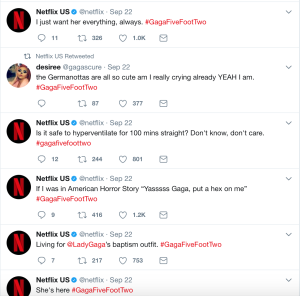 It has also been know to live tweet every once in a while, most recently the release of Lady Gaga’s documentary, “Five Foot Two” and the Emmy Awards ceremony in which a lot of its shows were nominated. When new shows or movies are being released, Twitter tends to blow up with original content about the show to flood its timeline and draw attention to the premiere. For instance, the most current example of this is its “Stranger Things” promotion that premieres at the end of the month. I do not think a day goes by that they do not post something about it, if not multiple things.
It has also been know to live tweet every once in a while, most recently the release of Lady Gaga’s documentary, “Five Foot Two” and the Emmy Awards ceremony in which a lot of its shows were nominated. When new shows or movies are being released, Twitter tends to blow up with original content about the show to flood its timeline and draw attention to the premiere. For instance, the most current example of this is its “Stranger Things” promotion that premieres at the end of the month. I do not think a day goes by that they do not post something about it, if not multiple things.
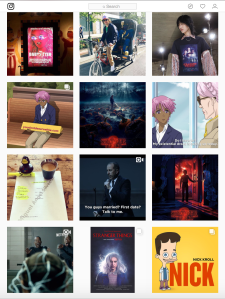 Instagram is just as much on the “Stranger Things” bandwagon as Twitter, although it might not post as much about it. However, out of the last month’s thirteen Instagram posts, five of them have been about “Stranger Things”. Instagram posts about three times a week, with each post promoting an upcoming show or movie. Usually its a video clip of a show or a series of pictures from a show. For some reason, the most common day of the week for Instagram to post is Wednesday, and I can only assume that is because its hyping up weekend releases and people are looking for something to look forward to mid-week.
Instagram is just as much on the “Stranger Things” bandwagon as Twitter, although it might not post as much about it. However, out of the last month’s thirteen Instagram posts, five of them have been about “Stranger Things”. Instagram posts about three times a week, with each post promoting an upcoming show or movie. Usually its a video clip of a show or a series of pictures from a show. For some reason, the most common day of the week for Instagram to post is Wednesday, and I can only assume that is because its hyping up weekend releases and people are looking for something to look forward to mid-week.
Contests
Unfortunately, Netflix is not big on running any contests with its followers, at least none that I can see. I’m not really sure what the prize would be if it did though, maybe a year of free streaming? The only direct consumer interaction besides replying to tweets from followers, cast members from its shows, and tweets from the show’s Twitter pages themselves, was polls on the Twitter page. One of them being “Is Nightmare Before Christmas a Halloween or Christmas movie?” in which the Halloween answer rightfully won (obviously). 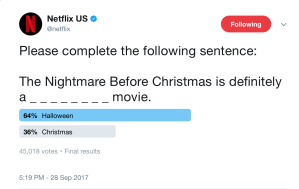
Engagement
The biggest way Netflix engages its fans is by creating original shareable content to promote its upcoming shows and movies. Whether it be a clip, meme, picture from behind the scenes or mention to a show’s cast member, Netflix knows that the more it pushes its content, the more its going to get shared and get attention. It uses a lot of hashtags on both Instagram and Twitter, usually correlating with whatever show its promoting. On Instagram, it will usually just tag the show with a hashtag every once in a while.
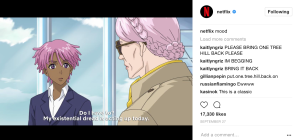 Another genius way that Netflix engages fans is by picking up on what its followers find funny and interesting. For example, Netflix has found that the show Neo Yokio, a Japanese anime, has a large following, so they post a lot of jokes and memes from that show, knowing fans will engage and its something they want to see.
Another genius way that Netflix engages fans is by picking up on what its followers find funny and interesting. For example, Netflix has found that the show Neo Yokio, a Japanese anime, has a large following, so they post a lot of jokes and memes from that show, knowing fans will engage and its something they want to see.
Another example is the large following Stranger Things has. Netflix knows that its release at the end of the month is going to be one of its biggest yet, therefore its really pushing the content regarding it because it knows it will gain a lot of engagement and its what its followers want to see right now given the Halloween season.
Perhaps one of the oddest and most comical examples of consumer engagement is the company’s awareness of the cult following certain characters from certain shows and movies tend to get, and acting on this opportunity. For some weird reason, a lot of its followers have an obsession with Tilda Swinton, Michael Cera and Bill Nye, awarding each with it’s own meme-esque post every once in a while.
Netflix also tends to flood its Instagram and Twitter accounts with posts promoting the release of one of its shows once it gets closer to the release dates, showing that it actually plans out a lot of its posts to correlate with what’s the most relevant at the moment. Like I mentioned previously, Stranger Things is its main focus right now since its one of its most popular shows and the new season premieres at the end of the month. Mid-November is probably going to start the heavy promotion of another popular show, The Crown, that premieres mid-December. It’s also going to be all over award season coverage, as nominations begin to filter out, probably prompting some live-tweeting.
The Good
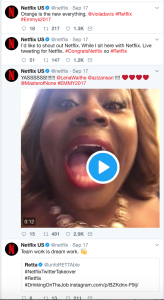 The best tweets are the ones that will get the most feedback and draw in the most attention. Twitter does this by varying the tweets it sends out and keeping an organized balance of content, retweets and mentions. However one of my favorite tweets, or series of tweets, was when Retta, who played Donna in Parks and Recreation, took over Netflix’s Twitter account and live-tweeted the Emmy Awards. She was up to date, funny and mastered the use of hashtags during the takeover. Plus it was a familiar face fans would recognize.
The best tweets are the ones that will get the most feedback and draw in the most attention. Twitter does this by varying the tweets it sends out and keeping an organized balance of content, retweets and mentions. However one of my favorite tweets, or series of tweets, was when Retta, who played Donna in Parks and Recreation, took over Netflix’s Twitter account and live-tweeted the Emmy Awards. She was up to date, funny and mastered the use of hashtags during the takeover. Plus it was a familiar face fans would recognize.
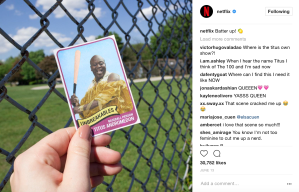 Sometimes you have to be in on the joke to get the joke. And that’s one concept Instagram has showed time and time again it understood. Take this post featuring Unbreakable Kimmy Schmidt character, Titus Andromedon. To a normal person who hasn’t seen the show, they probably don’t get the joke. To fans of the show, its meme gold. In the show, Titus spoofs Beyonce’s Lemonade album and vandalizes a neighborhood, just as Beyonce did in her “Hold Up” video. As you look at the post, you automatically know its a joke his character would make on the show, it references a scene from the show and you can almost hear the drama in his voice as you’re scrolling.
Sometimes you have to be in on the joke to get the joke. And that’s one concept Instagram has showed time and time again it understood. Take this post featuring Unbreakable Kimmy Schmidt character, Titus Andromedon. To a normal person who hasn’t seen the show, they probably don’t get the joke. To fans of the show, its meme gold. In the show, Titus spoofs Beyonce’s Lemonade album and vandalizes a neighborhood, just as Beyonce did in her “Hold Up” video. As you look at the post, you automatically know its a joke his character would make on the show, it references a scene from the show and you can almost hear the drama in his voice as you’re scrolling.
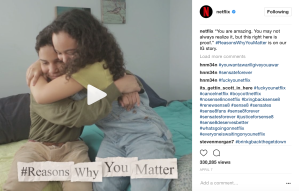 Another Instagram post I thought was smart was its #ReasonsWhyYouMatter campaign. In it, Netflix posted short videos of friends and family telling each other why they matter to them on its story. The reason it did this was to correlate it with the release of 13 Reasons Why, a Netflix show that got mixed reviews for covering a sensitive topic. To promote positivity surrounding the rather sad show, it decided to enlighten its followers with this heartfelt series of videos.
Another Instagram post I thought was smart was its #ReasonsWhyYouMatter campaign. In it, Netflix posted short videos of friends and family telling each other why they matter to them on its story. The reason it did this was to correlate it with the release of 13 Reasons Why, a Netflix show that got mixed reviews for covering a sensitive topic. To promote positivity surrounding the rather sad show, it decided to enlighten its followers with this heartfelt series of videos.
The last example of a good tweet, or should I say Twitter, is Netflix’s dedication to maintaining a theme this entire month of October. If you go on its page, more than half of its tweets have to do with horror films, Stranger Things or just Halloween in general. It’s taking advantage of the season and tapping on its horror/supernatural/sci-fi loving audience to engage them as much as it can right now. Tis’ the season.
The Bad
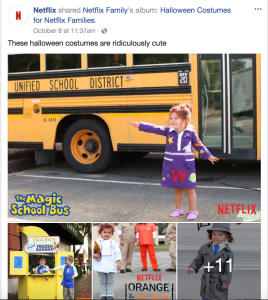 Honestly, the worst part about Netflix’s social media? Facebook. There’s just no original content! Instagram and Twitter both have its own audiences and know how to speak to and reach them. Facebook on the other hand, knows its audience but has a hard time reaching them. You can obviously see its trying to reach an older audience who are more family orientated, by posting specifically to them every once in a while, but not enough to say it has a strong voice with them. Almost everything found on Facebook can also be found on Twitter and Instagram.
Honestly, the worst part about Netflix’s social media? Facebook. There’s just no original content! Instagram and Twitter both have its own audiences and know how to speak to and reach them. Facebook on the other hand, knows its audience but has a hard time reaching them. You can obviously see its trying to reach an older audience who are more family orientated, by posting specifically to them every once in a while, but not enough to say it has a strong voice with them. Almost everything found on Facebook can also be found on Twitter and Instagram.
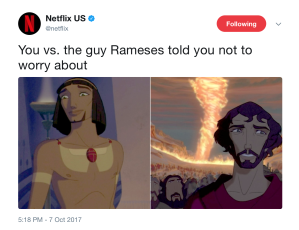 Another bad tweet is this one to the right. I get it, Netflix is trying to play into a popular and ongoing joke with younger generations, but it just doesn’t really have a place on its feed right now. It was tweeted a couple days ago, and doesn’t really go with the overarching Halloween theme its been following for the month and doesn’t correlate with any of its new releases. It’s not that its a bad post, just the timing of posting it was bad. If they posted it this summer or in correlation with that movie’s release onto Netflix, it would have worked much better.
Another bad tweet is this one to the right. I get it, Netflix is trying to play into a popular and ongoing joke with younger generations, but it just doesn’t really have a place on its feed right now. It was tweeted a couple days ago, and doesn’t really go with the overarching Halloween theme its been following for the month and doesn’t correlate with any of its new releases. It’s not that its a bad post, just the timing of posting it was bad. If they posted it this summer or in correlation with that movie’s release onto Netflix, it would have worked much better.
Overall, Netflix is doing a great job with its social media right now. It’s utilizing the platforms that it knows its biggest target audiences are on and creating original shareable content to keep them engaged. There is always something new to share, whether it be a new trailer or meme, so followers will definitely be paying attention. For being a brand that has so much to promote at one time, it does a good job of keeping it organized and original.



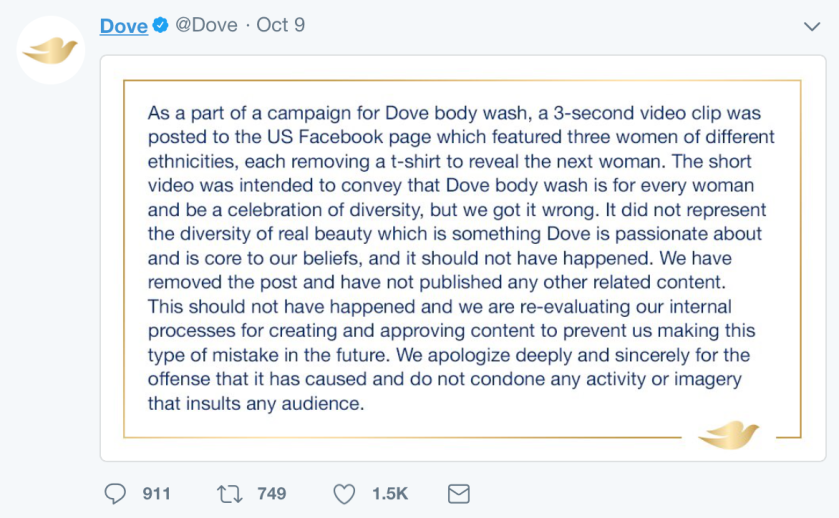
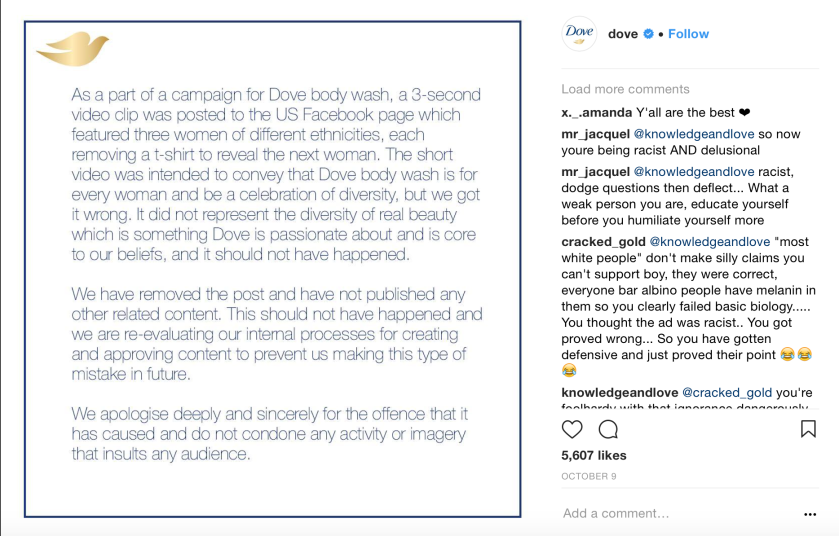
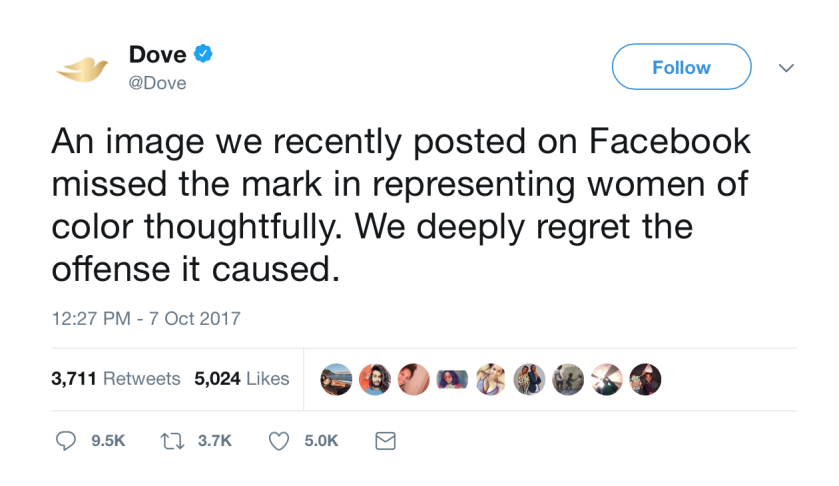












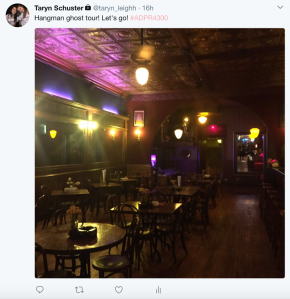


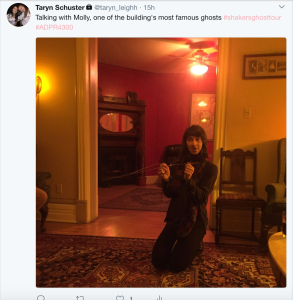 The tweet on the left is actually the highlight of the entire night. It’s our tour guide communicating with one the the building’s friendlier ghosts, Molly. Molly worked at the brothel back in the 20s, only to meet a tragic and early end when one of the speakeasy’s most prominent and regular customers strangled her to death. Our tour guide can be seen here using these metal rods to communicate with her, asking her to cross the rods to answer questions and point to where she was in the room. It was one of the scariest moments of the night when Molly actually decided to respond and point to where she was (right next to me nbd…).
The tweet on the left is actually the highlight of the entire night. It’s our tour guide communicating with one the the building’s friendlier ghosts, Molly. Molly worked at the brothel back in the 20s, only to meet a tragic and early end when one of the speakeasy’s most prominent and regular customers strangled her to death. Our tour guide can be seen here using these metal rods to communicate with her, asking her to cross the rods to answer questions and point to where she was in the room. It was one of the scariest moments of the night when Molly actually decided to respond and point to where she was (right next to me nbd…).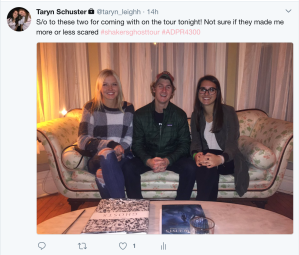 Last but not least is my favorite tweet of the night. This picture of my friends and me after the tour is a clear example of how the tour went. Our faces are uneasy with the terror but high off the adrenaline so we’re smiling through it. It was a really cool experience and I’m happy I could convince these two to come along. It would have been much worse if I were to go it alone. (P.S. I’m sitting in Molly’s favorite spot on the couch in the picture)
Last but not least is my favorite tweet of the night. This picture of my friends and me after the tour is a clear example of how the tour went. Our faces are uneasy with the terror but high off the adrenaline so we’re smiling through it. It was a really cool experience and I’m happy I could convince these two to come along. It would have been much worse if I were to go it alone. (P.S. I’m sitting in Molly’s favorite spot on the couch in the picture)







 It has also been know to live tweet every once in a while, most recently the release of Lady Gaga’s documentary, “Five Foot Two” and the Emmy Awards ceremony in which a lot of its shows were nominated. When new shows or movies are being released, Twitter tends to blow up with original content about the show to flood its timeline and draw attention to the premiere. For instance, the most current example of this is its “Stranger Things” promotion that premieres at the end of the month. I do not think a day goes by that they do not post something about it, if not multiple things.
It has also been know to live tweet every once in a while, most recently the release of Lady Gaga’s documentary, “Five Foot Two” and the Emmy Awards ceremony in which a lot of its shows were nominated. When new shows or movies are being released, Twitter tends to blow up with original content about the show to flood its timeline and draw attention to the premiere. For instance, the most current example of this is its “Stranger Things” promotion that premieres at the end of the month. I do not think a day goes by that they do not post something about it, if not multiple things. Instagram is just as much on the “Stranger Things” bandwagon as Twitter, although it might not post as much about it. However, out of the last month’s thirteen Instagram posts, five of them have been about “Stranger Things”. Instagram posts about three times a week, with each post promoting an upcoming show or movie. Usually its a video clip of a show or a series of pictures from a show. For some reason, the most common day of the week for Instagram to post is Wednesday, and I can only assume that is because its hyping up weekend releases and people are looking for something to look forward to mid-week.
Instagram is just as much on the “Stranger Things” bandwagon as Twitter, although it might not post as much about it. However, out of the last month’s thirteen Instagram posts, five of them have been about “Stranger Things”. Instagram posts about three times a week, with each post promoting an upcoming show or movie. Usually its a video clip of a show or a series of pictures from a show. For some reason, the most common day of the week for Instagram to post is Wednesday, and I can only assume that is because its hyping up weekend releases and people are looking for something to look forward to mid-week.




 Another genius way that Netflix engages fans is by picking up on what its followers find funny and interesting. For example, Netflix has found that the show Neo Yokio, a Japanese anime, has a large following, so they post a lot of jokes and memes from that show, knowing fans will engage and its something they want to see.
Another genius way that Netflix engages fans is by picking up on what its followers find funny and interesting. For example, Netflix has found that the show Neo Yokio, a Japanese anime, has a large following, so they post a lot of jokes and memes from that show, knowing fans will engage and its something they want to see.







 The best tweets are the ones that will get the most feedback and draw in the most attention. Twitter does this by varying the tweets it sends out and keeping an organized balance of content, retweets and mentions. However one of my favorite tweets, or series of tweets, was when Retta, who played Donna in Parks and Recreation, took over Netflix’s Twitter account and live-tweeted the Emmy Awards. She was up to date, funny and mastered the use of hashtags during the takeover. Plus it was a familiar face fans would recognize.
The best tweets are the ones that will get the most feedback and draw in the most attention. Twitter does this by varying the tweets it sends out and keeping an organized balance of content, retweets and mentions. However one of my favorite tweets, or series of tweets, was when Retta, who played Donna in Parks and Recreation, took over Netflix’s Twitter account and live-tweeted the Emmy Awards. She was up to date, funny and mastered the use of hashtags during the takeover. Plus it was a familiar face fans would recognize. Sometimes you have to be in on the joke to get the joke. And that’s one concept Instagram has showed time and time again it understood. Take this post featuring Unbreakable Kimmy Schmidt character, Titus Andromedon. To a normal person who hasn’t seen the show, they probably don’t get the joke. To fans of the show, its meme gold. In the show, Titus spoofs Beyonce’s Lemonade album and vandalizes a neighborhood, just as Beyonce did in her “Hold Up” video. As you look at the post, you automatically know its a joke his character would make on the show, it references a scene from the show and you can almost hear the drama in his voice as you’re scrolling.
Sometimes you have to be in on the joke to get the joke. And that’s one concept Instagram has showed time and time again it understood. Take this post featuring Unbreakable Kimmy Schmidt character, Titus Andromedon. To a normal person who hasn’t seen the show, they probably don’t get the joke. To fans of the show, its meme gold. In the show, Titus spoofs Beyonce’s Lemonade album and vandalizes a neighborhood, just as Beyonce did in her “Hold Up” video. As you look at the post, you automatically know its a joke his character would make on the show, it references a scene from the show and you can almost hear the drama in his voice as you’re scrolling. Another Instagram post I thought was smart was its #ReasonsWhyYouMatter campaign. In it, Netflix posted short videos of friends and family telling each other why they matter to them on its story. The reason it did this was to correlate it with the release of 13 Reasons Why, a Netflix show that got mixed reviews for covering a sensitive topic. To promote positivity surrounding the rather sad show, it decided to enlighten its followers with this heartfelt series of videos.
Another Instagram post I thought was smart was its #ReasonsWhyYouMatter campaign. In it, Netflix posted short videos of friends and family telling each other why they matter to them on its story. The reason it did this was to correlate it with the release of 13 Reasons Why, a Netflix show that got mixed reviews for covering a sensitive topic. To promote positivity surrounding the rather sad show, it decided to enlighten its followers with this heartfelt series of videos.



 Honestly, the worst part about Netflix’s social media? Facebook. There’s just no original content! Instagram and Twitter both have its own audiences and know how to speak to and reach them. Facebook on the other hand, knows its audience but has a hard time reaching them. You can obviously see its trying to reach an older audience who are more family orientated, by posting specifically to them every once in a while, but not enough to say it has a strong voice with them. Almost everything found on Facebook can also be found on Twitter and Instagram.
Honestly, the worst part about Netflix’s social media? Facebook. There’s just no original content! Instagram and Twitter both have its own audiences and know how to speak to and reach them. Facebook on the other hand, knows its audience but has a hard time reaching them. You can obviously see its trying to reach an older audience who are more family orientated, by posting specifically to them every once in a while, but not enough to say it has a strong voice with them. Almost everything found on Facebook can also be found on Twitter and Instagram. Another bad tweet is this one to the right. I get it, Netflix is trying to play into a popular and ongoing joke with younger generations, but it just doesn’t really have a place on its feed right now. It was tweeted a couple days ago, and doesn’t really go with the overarching Halloween theme its been following for the month and doesn’t correlate with any of its new releases. It’s not that its a bad post, just the timing of posting it was bad. If they posted it this summer or in correlation with that movie’s release onto Netflix, it would have worked much better.
Another bad tweet is this one to the right. I get it, Netflix is trying to play into a popular and ongoing joke with younger generations, but it just doesn’t really have a place on its feed right now. It was tweeted a couple days ago, and doesn’t really go with the overarching Halloween theme its been following for the month and doesn’t correlate with any of its new releases. It’s not that its a bad post, just the timing of posting it was bad. If they posted it this summer or in correlation with that movie’s release onto Netflix, it would have worked much better.